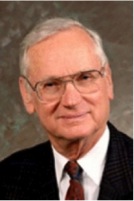

|

|
IN MEMORIAM
Kenneth M. Crowe
Professor of Physics, Emeritus
UC Berkeley
1926 – 2012
Professor Kenneth M. Crowe, a distinguished nuclear physicist who worked at Lawrence Berkeley National Laboratory from 1956 and served on the UC Berkeley Department of Physics faculty from 1958 to 1991, died February 1, 2012, at the age of 85.
A precocious student, Crowe skipped his senior year of high school to attend Brown University, graduating in 1948. He received his PhD from UC Berkeley in 1952, with Luis Alvarez and Wolfgang Panofsky on his doctoral committee. He joined Stanford University’s Hansen Laboratories of Physics, where he stayed until 1956, then returned to UC Berkeley to work at the Lawrence Radiation Laboratory – now the Lawrence Berkeley National Laboratory (LBNL).
Crowe co-authored with E. Richard Cohen and Jesse DuMond the influential textbook, Fundamental Constants of Physics, published in 1957. He joined the Berkeley physics faculty in 1958. His career focused on medium-energy experiments, in particular on the muon, the electron’s massive cousin. He is credited as a pioneer who defined these areas of study.
Crowe’s research was summarized in a March 13, 2012, obituary written by Paul Preuss of the LBNL News Center:
“Crowe’s forte was small-scale experiments of fundamental importance. Early on, much of his research could be performed at Berkeley Lab’s 184-Inch Cyclotron, while later he and his students and colleagues pursued projects at “meson factories” like the Los Alamos Meson Physics Facility in New Mexico, LAMPF (now LANSCE); TRIUMF in Vancouver, B.C.; and the Swiss Institute for Nuclear Physics, now the Paul Scherrer Institute (PSI). Beams of muons, the heavy and short-lived cousins of electrons, have excellent qualities for exploring the properties of molecules and materials, and muons also have the peculiar ability to catalyze nuclear fusion at low temperatures: replacing electrons in hydrogen molecules, their extra mass encourages the nuclei to fuse readily.
“Crowe was a leader in investigating these phenomena and their underlying principles. Many of his students and postdocs from the United States and other countries sought him out in Berkeley or were lucky enough to make his acquaintance here, and are now leaders in such fields as muon spin rotation and muon-catalyzed fusion. Beyond muons, medium energy physics embraces many other areas, and in the 1980s Crowe, together with European collaborators, conceived an experiment for the Low Energy Antiproton Ring (LEAR) at CERN called the Crystal Barrel, used to test the fundamental theory of nuclear physics, quantum chromodynamics (QCD). His work involved searching for exotic QCD states in relatively unexplored lower-energy regions.
“The Crystal Barrel experiment lasted several years, and during that time Crowe and his wife, Penny, lived across the border from CERN headquarters in the French countryside, a home fondly remembered by his colleagues, not least for Penny’s bouquets of wildflowers and her excellent cooking. In California the cooking was just as memorable, where home was a hexagonal house on stilts, on the waterfront in Point Richmond; Crowe built it himself from a kit and kept his boat tied to the rail.”
Crowe’s honors included being named a Fellow of the American Physical Society and a Fellow of the Japan Society for the Promotion of Science. He received the Humboldt Senior Scientist Award in 1987, and was a Scientific Associate in the CERN Fellowship Program from 1990-1991.
Crowe was an enthusiastic cellist. He took up the instrument after retirement and became accomplished enough to participate in a number of recitals. He was also a dedicated yachtsman and sailor who drew his students and postdocs into races on his 5.5 meter sloop.
Crowe is survived by his wife, Penny, and six children: Christina, Laura, Gabrielle, Cathy, Timothy, Jeffrey, and stepchildren, Michael and Karen.
Maria Hjelm, Development Officer, UCB Department of Physics